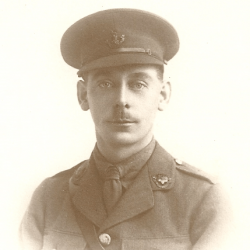Arthur James Southcott was born on July 18, 1895 in Woodford, Essex to Arthur Southcott, a civil servant at the royal mint and Annie Southcott (née Pattison). He was educated at The Cooper’s Company School, in London, and by 1911 was living in Woodford with his parents, his younger brother, Walter Roy Southcott, and a domestic servant. His father passed away on January 31, 1912.
Shortly after the outbreak of war, on September 3, 1914, he left his civilian job as a shipping clerk and joined the 9th (County of London) Battalion, London Regiment (Queen Victoria’s Rifles) as a Rifleman (#3177), undergoing 3 months basic training at Crowborough and Fleet. On November 5, 1914 the 1/9th London Regiment landed at Le Havre and went into the trenches at Neuve Eglise on November 29th recording their first casualties on December 4th. On December 31st they occupied the trenches again and the following day Rifleman Southcott sprained his back and was medically evacuated to England leaving France on January 5, 1915. Back in England he was assigned to the 2/9th Battalion while he recovered and there was granted a commission as a temporary Second-Lieutenant on March 27, 1915 with the 12th (Service) Battalion, The Essex Regiment.
He deployed to Gallipoli, and on October 7, 1915 was attached to the 1/9th Battalion, Manchester Regiment along with 4 other junior officers from the Essex and South Lancashire Regiments. There is no official mention of his movements or activities at Gallipoli save for a reference to reporting sick to hospital on December 4-8, 1915. He rejoined the Battalion on December 9th but two days later was admitted to the 17th Stationary Hospital at Cape Helles suffering from Diarrhea. He was medically evacuated to England on January 3, 1916 from Mudros sailing on the hospital ship Britannic and arrived at Southampton on January 9th, by now diagnosed with gastritis and enteritis.
He was given a month’s convalescent leave and on Feb 12, 1917 was pronounced fit for home service. A month later the Army medical board passed him fit for general service.
He deployed to France and was attached to the 10th Battalion, The Essex Regiment who at the time were part of the 53rd Brigade in 18th (Eastern) Division. They had taken heavy casualties in July at the Battle of Delville Wood and again in September at the Battle of Thiepval Ridge but on October 17, 1916 they were taking over the lines near Courcelette (S.W. of Bapaume). The battalion war diary simply states, “No 2 Platoon of “A” Company on reaching the BAPAUME POST was knocked out by a bomb from enemy aeroplane”. But a first-hand account of the incident provides more detail:
Account of Incident of Bomb from Enemy Aeroplane on morning of 17th October – by the [3] survivors:
“On the morning of the 17th inst. we were being marched up the BAPAUME ROAD in our platoon under 2/Lt. A. J. Southcott the platoon commander. When we reached the point on the road formerly known as BAPAUME POST a very heavy bomb fell and exploded about 3 yards to the left of the centre of the platoon. This was at about 5:40am when the light was poor and there was a heavy mist issuing from the river. All the platoon were rendered casualties except ourselves. Officer (2/Lt. A. J. Southcott) wounded. Other ranks: 1 killed and 17 wounded.
We were marching at ease at the time and were singing so no one either heard the aeroplane or the noise of the bomb descending. After the explosion we immediately commenced to bandage the wounded and some 3 or 4 minutes after the explosion we saw the aeroplane hovering fairly low little distance to the right, where it dropped another bomb. There were lights and fires burning in the camps both on the right and left of the road where the bombs were dropped.”
2/Lt. Southcott was struck by a fragment of bomb shrapnel which entered the lower part of the right buttock passing through the rectum from which it passed 3 days later, which can’t have been pleasant. He was medically evacuated to England on the Asturias embarking at Le Havre on October 20 and disembarking at Southampton on the 21st where he was transported to London and admitted to Lady Mountgarret’s Convalescent Hospital for Officers. The wound became septic but healed reasonably quickly but he then developed Gastritis and Enteritis as he had before in Gallipoli. It was not until June 16, 1917 that he was finally pronounced fit for general service again whereupon he proceeded to the 27th Training Reserve Battalion, Harwich Fortress at Dovercourt, Essex.
On June 7, 1918 he suffered the humiliation of a Field General Court Martial, accused of Drunkenness at Felixstowe on May 13. He pleaded Not Guilty but was found Guilty and severely reprimanded. He relinquished his commission and left the Army on February 23, 1919 retaining the rank of Lieutenant.
In 1920 he applied to the War Office for his medals and the contact address was later amended from his mother’s home in Essex to that of the Militia Council Headquarters, in Ottowa, Canada. He officially emigrated to Canada in March 1923 and became the head clerk at an aircraft engine manufacturer called Armstrong-Siddeley, (later to become Hawker-Siddeley), in Ottowa. Lt. Arthur James Southcott died suddenly on June 31, 1935 and is buried in the Beechwood Cemetery, Ottowa. He was 39 years old.

